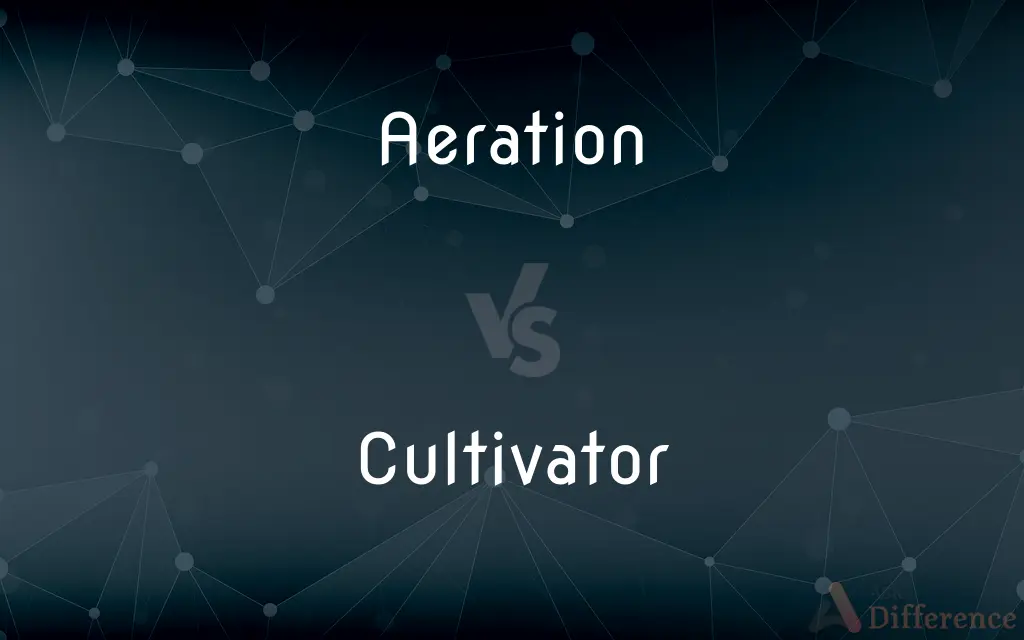Aeration vs. Cultivator — What's the Difference?
By Tayyaba Rehman — Updated on October 7, 2023
Aeration introduces air into a substance, usually soil, while a cultivator is a tool or machine used to prepare and break up soil for planting.

Difference Between Aeration and Cultivator
Table of Contents
ADVERTISEMENT
Key Differences
Aeration and Cultivator both relate to soil treatment but serve different primary functions. Aeration is the process of introducing air into a substance, especially soil. This is often done to improve soil health by ensuring that oxygen reaches plant roots. On the other hand, a cultivator is a tool or machine specifically designed to break up and stir soil, preparing it for planting.
In terms of improving soil conditions, aeration can help compacted soils become looser, promoting root growth and water absorption. This process can be particularly beneficial for lawns or sports fields that experience heavy foot traffic. A cultivator, however, is employed to disturb the soil at a more superficial level. It aids in weed control, mixes organic matter, and helps create a smooth bed for sowing seeds.
Aeration techniques can involve poking holes into the ground or removing plugs of soil. These methods ensure that the soil doesn't become too compacted, which could stunt plant growth. In contrast, a cultivator can be manual, like a hand tool, or mechanized, like a machine that tills large plots of land. Both aeration and the use of cultivators improve soil health but address different challenges.
The tools used for aeration are usually aerators or spike shoes, focusing solely on creating passages for air. The cultivator's primary design is for tilling, often featuring rotating blades or tines that dig into the earth. While both aeration and cultivators enhance the condition of soil, they do so with distinct mechanisms and purposes.
Comparison Chart
Primary Purpose
Introducing air into soil.
Breaking up and stirring soil.
ADVERTISEMENT
Benefit
Loosens compacted soil, promotes root growth.
Prepares soil for planting, aids in weed control.
Tools/Methods
Aerators, spike shoes.
Hand tools, mechanized tillers.
Soil Depth Impact
Typically superficial, affecting a few inches of the topsoil.
Can affect both surface and deeper layers of soil.
Frequency
Done periodically, based on soil compaction.
Done before planting or whenever soil preparation is needed.
Compare with Definitions
Aeration
Enhancing the amount of air in soil to improve plant growth.
Lawn aeration helped the grass grow more lushly.
Cultivator
A person who cultivates, especially crops or a specific culture.
As a cultivator of rare orchids, she was well-respected in the horticultural community.
Aeration
The process to prevent soil from becoming too compacted.
Regular aeration is essential for maintaining the school's soccer field.
Cultivator
A tool or machine for loosening soil before planting.
He used the cultivator to prepare the garden beds.
Aeration
The process of introducing air into a substance.
The pond required aeration to maintain healthy fish.
Cultivator
A hand tool used to uproot weeds and mix soil.
She preferred using a hand cultivator for the small garden patch.
Aeration
Introducing air into a liquid, often to improve taste or texture.
Aeration of the wine improved its flavor profile.
Cultivator
An implement with rotating blades for breaking up soil.
The motorized cultivator made tilling the large plot much easier.
Aeration
Circulating air in confined spaces for improved ventilation.
The basement needed aeration to prevent mold growth.
Cultivator
A cultivator is an agricultural equipment used for secondary tillage. One sense of the name refers to frames with teeth (also called shanks) that pierce the soil as they are dragged through it linearly.
Aeration
Aeration (also called aerification or aeriation) is the process by which air is circulated through, mixed with or dissolved in a liquid.
Cultivator
One who cultivates
An inveterate cultivator of beautiful gardens.
A cultivator of valuable corporate contacts.
Aeration
To supply with air or expose to the circulation of air
Aerate soil.
Cultivator
An implement or machine for loosening the soil and destroying weeds around growing plants.
Aeration
To expose to oxygen, as in the oxygenation of the blood by respiration.
Cultivator
Any of several devices used to loosen or stir the soil, either to remove weeds or to provide aeration and drainage.
Aeration
To supply or charge (liquid) with a gas, especially to charge with carbon dioxide.
Cultivator
A person who cultivates.
Aeration
The process by which air is circulated through or mixed with a substance such as soil or a liquid.
Cultivator
One who cultivates; as, a cultivator of the soil; a cultivator of literature.
Aeration
By extension, a process in which other gases (such as carbon dioxide or nitrogen or argon) are circulated through or mixed with a substance (usually liquid), sometimes with the consequence of increasing the transfer of air into the same liquid at the surface due to the induced circulation.
Cultivator
An agricultural implement used in the tillage of growing crops, to loosen the surface of the earth and kill the weeds; esp., a triangular frame set with small shares, drawn by a horse and by handles.
Aeration
Exposure to the free action of the air; airing; as, aëration of soil, of spawn, etc.
Cultivator
Someone concerned with the science or art or business of cultivating the soil
Aeration
A change produced in the blood by exposure to the air in respiration; oxygenation of the blood in respiration; arterialization.
Cultivator
A farm implement used to break up the surface of the soil (for aeration and weed control and conservation of moisture)
Aeration
The act or preparation of charging a liquid with carbon dioxide gas to make it effervescent.
Cultivator
A device aiding in the preparation and enrichment of soil for planting.
Investing in a good cultivator made his farming activities more efficient.
Aeration
The act of charging a liquid with air or oxygen for the purpose of purification.
Aeration
The process of exposing to air (so as to purify)
Aeration
The act of charging a liquid with a gas making it effervescent
Common Curiosities
What is the primary purpose of aeration?
Aeration introduces air into substances, particularly soil, to improve its health and promote plant growth.
How often should soil be aerated?
Soil aeration frequency depends on the level of soil compaction and the specific needs of the area.
Can a cultivator be a manual tool?
Yes, cultivators can be manual hand tools or larger mechanized machines.
Do cultivators always have rotating blades?
While many cultivators have rotating blades or tines, some manual versions might not.
Can aeration be used in water?
Yes, aeration can be applied in water bodies like ponds to maintain oxygen levels for aquatic life.
Can aeration improve the taste of liquids like wine?
Yes, aeration can enhance the flavor profile of wines and other liquids.
Is aeration essential for all types of soil?
Not all soils require aeration, but those experiencing compaction or reduced air circulation can benefit from it.
Are cultivators useful for weed control?
Yes, cultivators can help in uprooting and controlling weeds in the soil.
What is a cultivator used for?
A cultivator is used to break up and stir soil, preparing it for planting and aiding in weed control.
Does aeration help with compacted soil?
Yes, aeration can loosen compacted soil, allowing better water absorption and root growth.
What's the difference between a tiller and a cultivator?
While similar, a tiller is generally more powerful and can dig deeper than a cultivator.
Are cultivators only used in agriculture?
While commonly used in agriculture, cultivators can be used in any setting where soil preparation is needed.
Does aeration affect only the surface of the soil?
Aeration mainly impacts the surface, affecting a few inches of the topsoil, though the depth can vary.
What tools are associated with aeration?
Aerators and spike shoes are commonly used for soil aeration.
How deep can a cultivator break the soil?
The depth a cultivator affects can vary, ranging from surface-level to deeper layers depending on the tool or machine used.
Share Your Discovery

Previous Comparison
Transparent vs. Clear
Next Comparison
Barrister vs. BaristaAuthor Spotlight
Written by
Tayyaba RehmanTayyaba Rehman is a distinguished writer, currently serving as a primary contributor to askdifference.com. As a researcher in semantics and etymology, Tayyaba's passion for the complexity of languages and their distinctions has found a perfect home on the platform. Tayyaba delves into the intricacies of language, distinguishing between commonly confused words and phrases, thereby providing clarity for readers worldwide.
















































